There are seven types of Carpet Pythons and they each have different colors and patterns.
The most well-known species is the Jungle variety that is black with yellow bands.
Carpet Python snakes are one of the most popular pet python species. This is because of their attractive colors, calm adult temperament and manageable size.
They are small when compared with many pythons such as the reticulated.
This species thrives in captivity, but needs an enclosure that is appropriate. Read on to learn how to handle and care for this snake and build the correct enclosure…
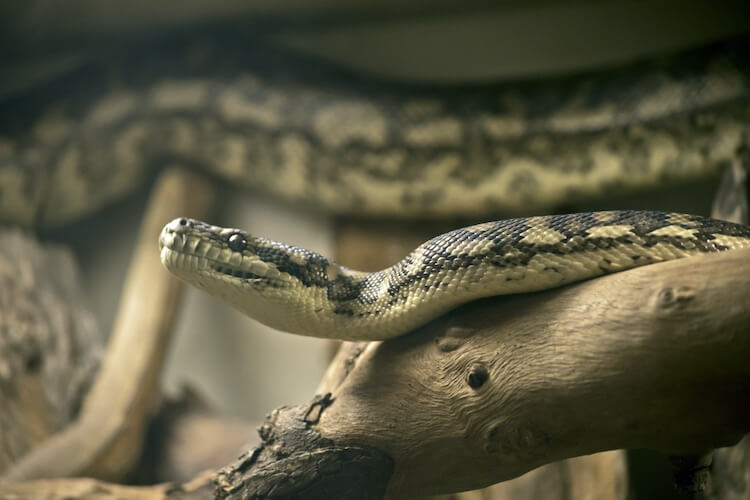
Carpet Python Overview
Carpet Pythons are named after their pattern scale that looks just like an oriental carpet.
This Python is normally found living in woodlands and savannas across the North, South and Eastern coasts of Australia. Sometimes they are found in the southern tip of Papua New Guinea too.
Their color varies based on their subspecies, but most individuals have different patterns of black, brown and yellow.
Size is also dependent on subspecies. Some adults can exceed 12 feet when fully grown but most are five to eight feet in length.
Similar to other pet snakes (e.g. Boas and Pitvipers) this species has heat-sensing pits on their face. This helps them to detect warm-blooded prey and means they are able to hunt at nighttime.
This species is semi-arboreal so it is not uncommon for them to be found climbing trees.
In the wild they will climb tress to ambush their prey (e.g. rats, possums, birds and lizards).
Types Of Carpet Pythons
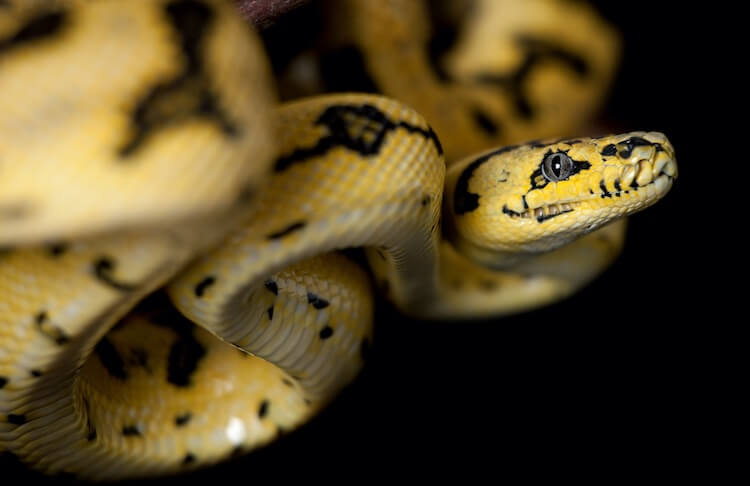
There are seven recognized subspecies of Carpet Python (Morelia spilota):
- Morelia spilota cheynei – Jungle.
- Morelia spilota harrisoni – Irian Jaya / Papuan.
- Morelia spilota imbricata – Southwestern.
- Morelia spilota mcdowelli – Coastal.
- Morelia spilota metcalfei – Inland.
- Morelia spilota spilota – Diamond.
- Morelia spilota variegata – Darwin / Northwestern.
These subspecies can be bred together to create different morphs and combinations of appearances.
Do Carpet Pythons Make Good Pets?
Yes they are very popular with reptile keepers. This is because of their manageable adult size, generally calm temperament and attractive color variety.
Pros
- Several striking natural color varieties.
- More manageable size than most python species (e.g. Reticulated and Burmese).
- Generally calm adult temperament.
Cons
- More expensive than most Python species.
- Adults require large enclosures at least four feet long.
- Hatchlings and juveniles are known to take months to tame.
Species Appearance
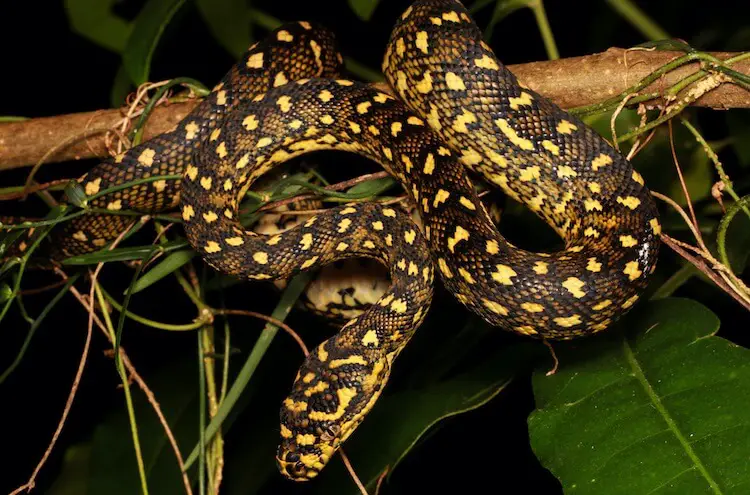
The seven subspecies of Carpet Pythons are often bred together to create morphs. It can be difficult to identify which subspecies you have unless your breeder is sure of the parents’ subspecies.
Most individuals have different patterns of black, brown and yellow.
There are some characteristics that can help identify a specific Carpet Pythons subspecies:
Jungle Carpet Pythons have very striking yellow and black colors with an average adult size of six to seven feet.
Southwestern species are large and grow to eight feet. Their appearance is normally a brown base color with irregular lighter-colored markings.
Coastals are the largest and can grow 10 feet long.
Inlands are one of the smaller subspecies and grow four to five feet. They have beautiful black banding on a bluish-gray background.
Diamond species (pictured above) have light yellow scales that each have a darker background. This creates a network of small markings.
Darwin species normally have an orange or reddish brown base color with lighter bands outlined in black across their body. This subspecies grows to just under six feet.
Irian Jayas are the only subspecies found outside of Australia, in Papua New Guinea. They look very similar to a Darwin but are slightly smaller at five feet.
How Big Do Carpet Pythons Grow?
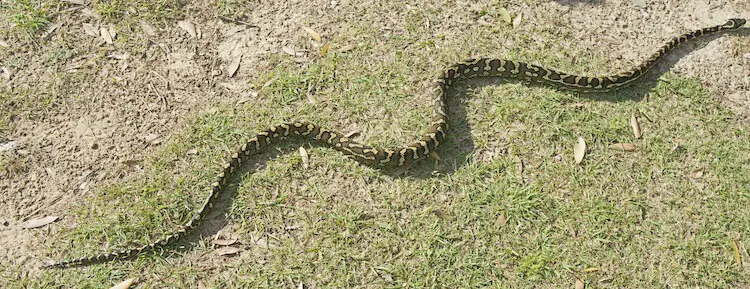
Most adult Carpet Pythons grow between five and eight feet. Each subspecies is unique and will grow to a different adult length:
| Subspecies | Adult Size (feet)* |
|---|---|
| Jungle Carpet | 6 to 7 |
| Southwestern | Up to 8 |
| Coastal | Up to 10 |
| Inland | 4 to 5 |
| Diamond | Up to 7 |
| Darwin | Up to 6 |
| Irian Jaya | 5 to 6 |
* The frequency and size of meals combined with the subspecies of Carpet Python will impact growth rate and adult size.
Hatchlings are born 12 to 14 inches long. They grow to their adult size within two years. A captive individual had the following growth over its first year:
| Age (months) | Weight (grams) | Snout–Vent Length (inches) |
|---|---|---|
| 1 | 50 | 23 |
| 3 | 150 | 33 |
| 6 | 600 | 49 |
| 9 | 1,600 | 61 |
| 12 | 3,000 | 70 |
Carpet Python Care Sheet
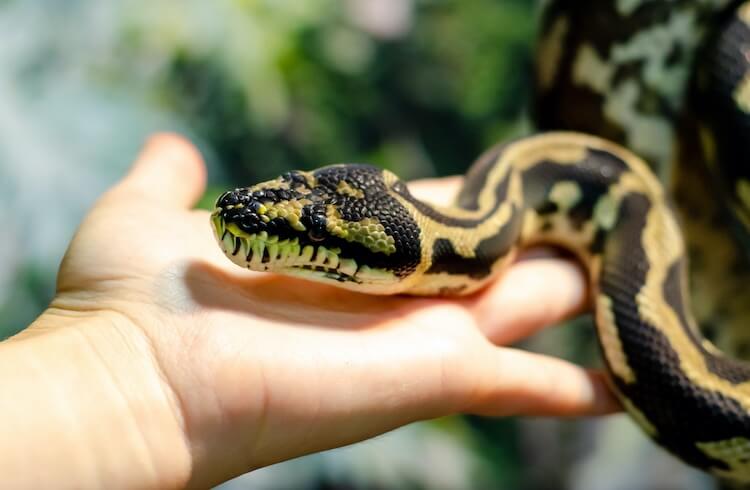
Carpet Python Diet
Wild species eat lizards, birds and rodents.
In captivity Carpet Pythons are normally fed rodents.
Young Pythons (i.e. juveniles) can eat mice, but we recommend starting them on rats as soon as possible. This will save you from having to switch their diet as adults.
A good feeding guide is:
- Hatchlings: 1 x fuzzy mouse every 7 days.
- Small juveniles: 1 x hopper mouse every 7 to 10 days.
- Juveniles: 1 x pinky rat every 7 to 10 days.
- Adults: 1 x rat every 2 weeks.
Growth rates of individual snakes will vary but you should be increasing the size of the rat according to the size of your snake. You should try not to feed rodents that are larger than your snake is at its widest girth as they can cause digestion issues.
A 10-day feeding schedule is best until your Python reaches a healthy adult size. After this, if you do not intend to breed your Carpet Python, you can feed them every two to four weeks. Just make sure they are maintaining a healthy body weight.
Health and Lifespan
Pythons are generally hardy snakes and do not have any specific health issues to look out for.
They should always be given proper care and husbandry. Routine husbandry can help prevent some common issues associated with captive snakes:
- Incorrect humidity can cause respiratory issues or shedding problems.
- Improper tank sanitation can lead to scale rot or mite infestations.
- Wrong tank size can lead to feeding problems or regurgitation.
Carpet Pythons live for 20 to 30 years in captivity.
Signs They Are Healthy
- Well-defined muscle mass.
- Proper body size in relation to weight.
- Smooth iridescent skin.
- Uses the cage’s temperature gradient.
Sickness Symptoms
- Ribs are visible.
- Snake is too overweight to move properly.
- Skin has stuck shed or damaged scales.
- Always soaking or on the same side of the cage.
Carpet Python Enclosure
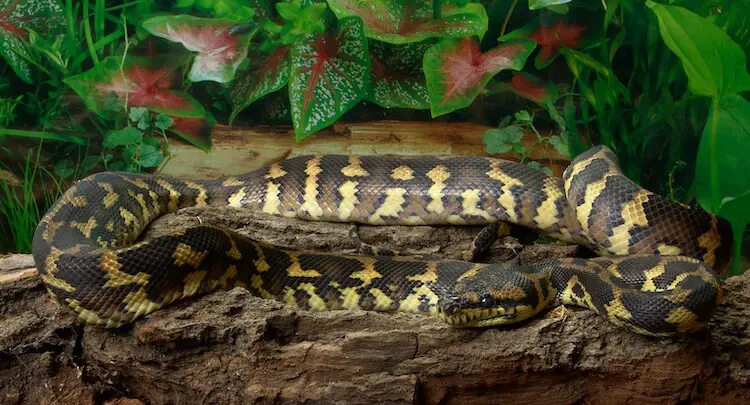
Carpet Pythons live in a wide range of habitats throughout Australia and the southern tip of Papua New Guinea. These snakes are normally found in savanna and woodland areas.
Despite being small baby Carpet Pythons will grow five to eight feet long.
Because of this, they need a large enclosure. Babies and juveniles can be kept in 40-gallon long terrariums. However, they will not fit in this tank forever and are best kept in six feet long enclosures.
Their enclosure can be a glass terrarium or custom-made:
- Tank Type: glass or custom made.
- Tank Size: minimum 4′ feet long.
- Lighting: none.
- Substrate: aspen or cypress mulch.
Cage Set Up
A Carpet Python’s enclosure needs a temperature gradient so they can regulate their body heat. The hot side of their cage should be 85 to 90°F and the ambient side should be 70 to 75°F.
To regulate the cage temperature you can use a heat pad or heat tape hooked up to a thermostat.
Carpet Pythons do not need special humidity levels.
Common household humidity levels of 40 to 50% are perfectly fine.
You will need to add at least one hide in their enclosure. To make sure they feel secure we recommended having a hide on both the hot and cold side of the cage. Make sure the hide is large enough for your snake to fit comfortably. If you notice your snake is about to shed then give them a moist hide.
The enclosure should have a water bowl for your snake to drink from. This bowl should be monitored and kept clean as needed.
Finally, Carpet Pythons (especially as juveniles) are semi-arboreal. They will greatly appreciate some trees and décor to climb on (pictured below).
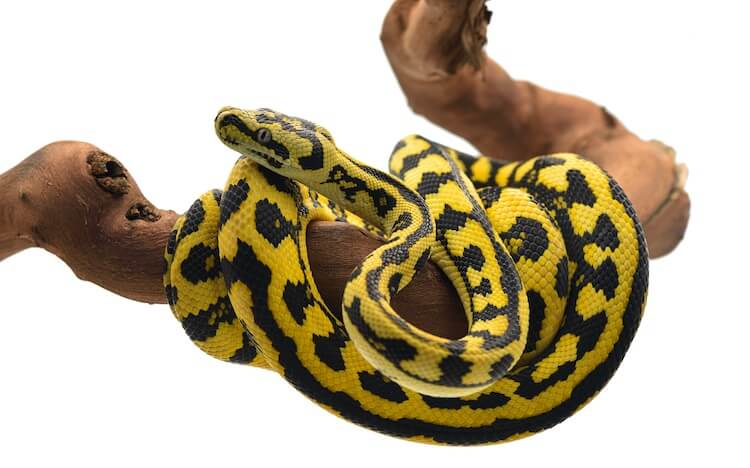
Carpet Python Substrate
There are many different substrates that can be used for a Carpet Python.
Just newspaper can be used, but your snake will appreciate something natural. Aspen shavings and cypress mulch are two safe and popular substrates.
If you are not buying substrate specifically made for reptiles then make sure it does not have any added chemicals.
Spot clean the bedding whenever your Python soils it and replace the bedding completely every two weeks.
Carpet Python Temperament
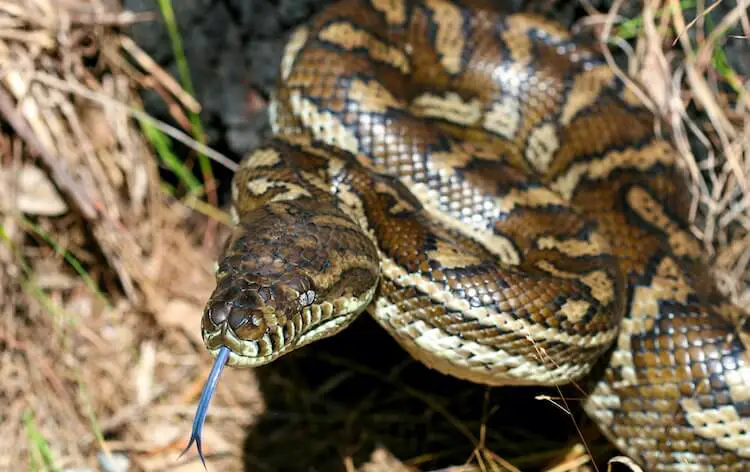
In the wild these snakes are not very aggressive.
They are not a threat to humans and are very often encountered in Australia when they approach houses in search of food.
Carpet Pythons are nocturnal so they will spend most of the day resting in their hide.
At nighttime your snake will be active and exploring their tank.
A healthy snake will spend time on both sides of the cage. This will help them regulate their temperature. If your snake is spending all of their time on the hot side then their enclosure may be too cold. Similarly if they are spending all of their time on the cold side then their hot spot may be uncomfortably hot.
Most well-cared for adults are docile.
In captivity juveniles are often nippy and head shy.
With regular contact and handling they will generally calm down as they age.
Are Carpet Pythons Venomous?
No. Carpet Pythons are not venomous and pose no threat to humans.
Juveniles can be nippy and head-shy. This means they will quickly pull back if their head touches something — this is normal.
Luckily their nips are not painful and Carpet Pythons can be tamed with consistent and proper handling.
You should not handle your snake after feeding as this can cause regurgitation. If your snake is in shed and their eyecaps are blue you should also not attempt to handle.
Baby Carpet Python: Buyer’s Guide
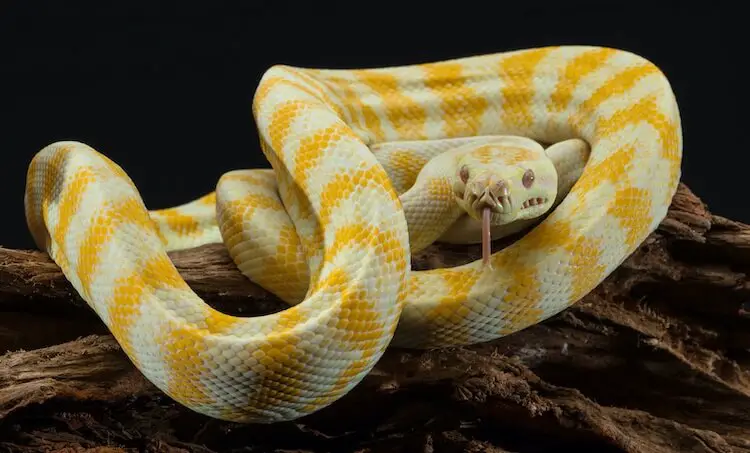
There are many private breeders of Carpet Pythons.
The first thing you should check is that you are buying a captive-bred species.
You should then make sure your snake does not have any foreign parasites or health issues. Make sure it is a healthy weight and does not have any stuck shed.
Healthy Carpet Pythons should be active and alert. Extreme aggression can be a sign of stress, but a snake that is extremely lethargic is probably not in the best health either.
How Much Is A Carpet Python?
This species of Python is not usually cheap and neither is their enclosure. Carpet Pythons cost over $150. Depending on the subspecies, size and morph they can cost $1,000.
An enclosure suitable for a large adult will cost upwards of $500. You will also need to spend another $200 to properly set up the tank.
This snake can be expensive to keep – especially as adults.
What Is It Like To Keep This Pet?
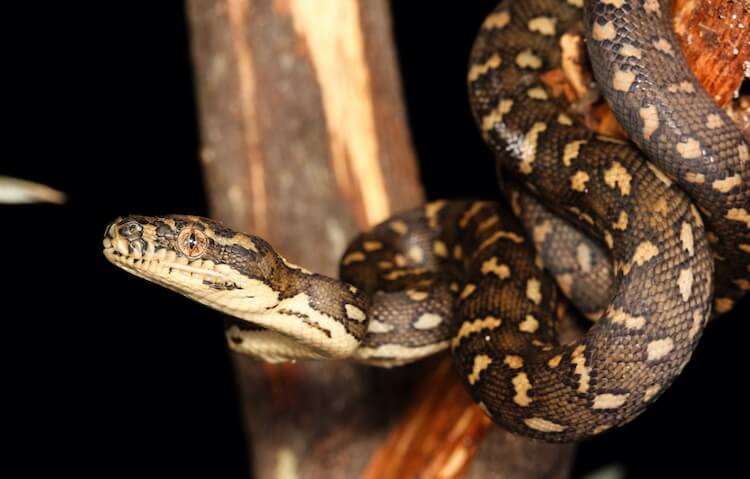
When you first bring home your Carpet Python snake you should leave him in his enclosure for a couple of weeks. This will let him get used to his new environment.
You should also wait for a couple of weeks before you start handling him.
Juveniles are likely to be jumpy and nippy.
You should start to interact with your snake on a regular basis after a month. This will help them get used to human contact.
Cleaning and feeding are the backbone of any owners husbandry routine.
Juvenile Carpet Pythons will need to be fed rats every week.
You will also need to spot clean the cage daily, keep the water bowl clean and change the substrate every two weeks.
Facts About Carpet Pythons
| Common Name | Carpet Python |
|---|---|
| Scientific Name | Morelia spilota ssp |
| Subspecies | Seven |
| Price | ~$150 |
| Size | 5 to 8 feet long |
| Weight | 30 pounds |
| Lifespan | 20 to 30 years |
| Diet | Rodents |
| Tank Size | Minimum 4 feet |
| Humidity & Temperature | Temperature: 85 to 90°F Ambient Temperature: 70 to 75°F Humidity: 40 to 50% |
| Popular Alternatives | Ball Python, Red Tail Boa and Rosy Boa |
Summary
Carpet Pythons are a beautiful species of snake found in Australia and Papua New Guinea. There are seven recognized subspecies that has its own color, pattern, size, and niche range.
Most subspecies are brown or black with have patterns of yellow.
These snakes are very common pets and are also available in different color morphs.
Carpet Pythons do not have any special humidity requirements. Their tank temperature is easily maintained with a heat source and thermostat.
Most adults reach at least five feet in length and need large cages.
When cared for properly, these Pythons are large, beautiful, and docile. What are you experiences with Carpet Pythons? Let us know.

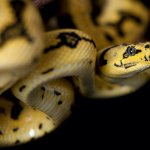
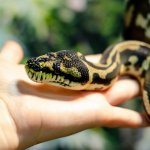
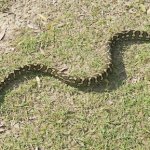
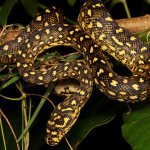
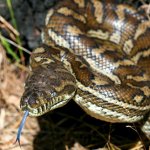
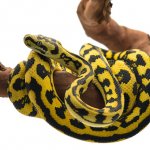
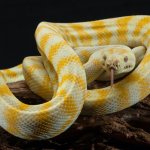
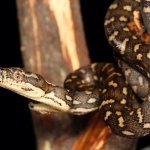
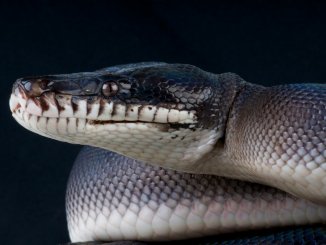
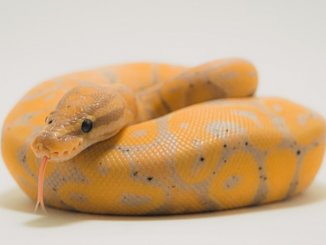
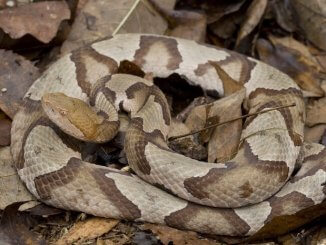

Do I need any specific permits to legally own a carpet python in the state of Texas?
I don’t think you need a permit to own a King Cobra, let alone a Carpet Python, which is a common pet snake nowadays
Hi looking for some info
I have albino jungle caarpet python.
What colour does its eyes go When in blue ?
“although babies are small…”
Ok but is almost two feet long at 1 month out of the egg really considered *small* though?
Carpets are long but not heavy. Common boas, especially morph boas grow pretty fast and gain girth over length, but say a Blood Python hardly gets very long but is super heavy for the same length as other snakes etc. So going by length alone is a bit misleading. A 10 foot Carpet is WAY more manageable than a 10ft boa haha (or God forbid a blood python 0.0)
Since building a workshop in 1993 I have had resident Carpet snakes( Rural area).
Obvious from ever-lenghtening shed skins every year that the same snake has lived there for 10-12 years at least even more.
Today Mar.2022 sighted another one…about 1 metre( 3 feet) long on a shelf in Workshop…dry with storms outside. Placid.
Will check later.
Another one is around House taking care of Mice and Geckos. Another skin shedding..about 2 ft. Have seen before ( several months ago. All Nice beasties, placid, easy to get on with.